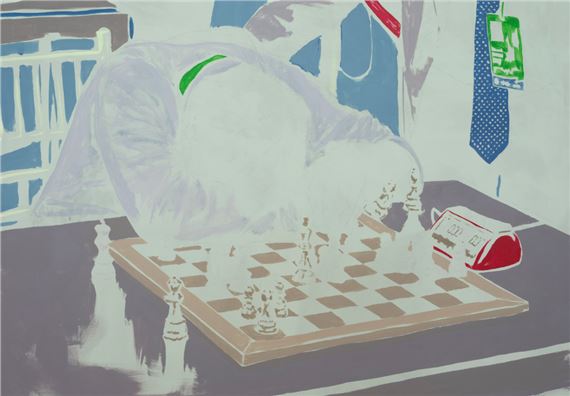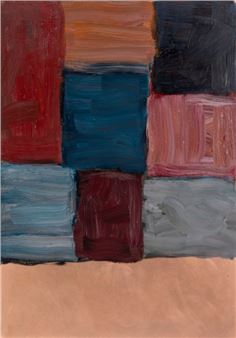Lee Welch: Oedipus
In the myth of Oedipus, the act of seeing is both literal and symbolic, only in blindness does he come to understand the truth.
Lee Welch’s exhibition Oedipus spans painting, printmaking, and installation, offering an arresting meditation on how we see, remember, and relate to the world. His visual language is spare but loaded figures, gestures, and fragments reduced to essentials that carry emotional weight. Paintings in the exhibition feature references pulled from art history, popular culture, and the mundane rituals of daily life.
In all silently concentrating (2025), tourists mime, attempting to hold up the Leaning Tower of Pisa, rendered in translucent tones on raw-edged polyester, the image resists completion. It’s an illusion about illusions, collective participation in a performance in which no one quite believes.
In All is vanity (2025) nods to Charles Allan Gilbert’s famous double image of a woman and skull. Lee’s version trembles in and out of legibility, echoing the instability of perception in the age of deepfakes and visual noise.
In epochal defining while one creates beautiful problems (2025), the chess legend Vasyl Ivanchuk is caught mid-defeat, a faded figure on the brink of collapse.
In For a long time I had wanted (2025) Lee quietly honours composer Arvo Pärt with somber greys and a single red accent, reflecting the stillness and restraint of his music. The work feels intimate but universal, offering space for personal projection.
In A whole string of failures (2025) a figure is buried under books, a nod to burnout and the paralysis of overthinking.
In The smallest daily chore can be humanised (2025) an empty lilac-tinted interior is depicted, saturated with absence.
In Mindless superstition and pointless ritual (2025), painted on a furniture remover’s blanket, Lee strips away Andy Kaufman’s performative layers to reveal a sense of impermanence.
In I’m just going to leave it (2025), a fleeting moment from the Golden Globes is painted of Cillian Murphy’s wife wiping lipstick off his face. It becomes a portrait of care, exposure, and the quiet vulnerability that exists behind public performance.
In aqua seafoam shame (2025), Lee traces a long lineage of artistic influence, working from a Jasper John’s painting of Lucian Freud, which itself was based on a John Deakin photograph found in Francis Bacon’s studio. The result is a layered meditation on authorship, image circulation, and emotional inheritance.
In all at once (2025), Lee references Paul Atreides from Dune, imagining blindness as another form of insight, asking what it means to see with more than just vision.
In Oedipus, The Gallery space itself is interrupted by an architectural intervention, slicing the gallery into sections, creating competing sightlines. Lee uses this divide to challenge how and from where meaning is constructed, emphasising the viewer’s role in shaping what they see. The paintings in the exhibition are restrained and elliptical, but their effect is long lasting. Lee doesn’t just document a fractured world within Oedipus, he recreates the textures of living in it: the disorientation, the fragility, the fleeting moments of connection that still, somehow, endure.

In the myth of Oedipus, the act of seeing is both literal and symbolic, only in blindness does he come to understand the truth.
Lee Welch’s exhibition Oedipus spans painting, printmaking, and installation, offering an arresting meditation on how we see, remember, and relate to the world. His visual language is spare but loaded figures, gestures, and fragments reduced to essentials that carry emotional weight. Paintings in the exhibition feature references pulled from art history, popular culture, and the mundane rituals of daily life.
In all silently concentrating (2025), tourists mime, attempting to hold up the Leaning Tower of Pisa, rendered in translucent tones on raw-edged polyester, the image resists completion. It’s an illusion about illusions, collective participation in a performance in which no one quite believes.
In All is vanity (2025) nods to Charles Allan Gilbert’s famous double image of a woman and skull. Lee’s version trembles in and out of legibility, echoing the instability of perception in the age of deepfakes and visual noise.
In epochal defining while one creates beautiful problems (2025), the chess legend Vasyl Ivanchuk is caught mid-defeat, a faded figure on the brink of collapse.
In For a long time I had wanted (2025) Lee quietly honours composer Arvo Pärt with somber greys and a single red accent, reflecting the stillness and restraint of his music. The work feels intimate but universal, offering space for personal projection.
In A whole string of failures (2025) a figure is buried under books, a nod to burnout and the paralysis of overthinking.
In The smallest daily chore can be humanised (2025) an empty lilac-tinted interior is depicted, saturated with absence.
In Mindless superstition and pointless ritual (2025), painted on a furniture remover’s blanket, Lee strips away Andy Kaufman’s performative layers to reveal a sense of impermanence.
In I’m just going to leave it (2025), a fleeting moment from the Golden Globes is painted of Cillian Murphy’s wife wiping lipstick off his face. It becomes a portrait of care, exposure, and the quiet vulnerability that exists behind public performance.
In aqua seafoam shame (2025), Lee traces a long lineage of artistic influence, working from a Jasper John’s painting of Lucian Freud, which itself was based on a John Deakin photograph found in Francis Bacon’s studio. The result is a layered meditation on authorship, image circulation, and emotional inheritance.
In all at once (2025), Lee references Paul Atreides from Dune, imagining blindness as another form of insight, asking what it means to see with more than just vision.
In Oedipus, The Gallery space itself is interrupted by an architectural intervention, slicing the gallery into sections, creating competing sightlines. Lee uses this divide to challenge how and from where meaning is constructed, emphasising the viewer’s role in shaping what they see. The paintings in the exhibition are restrained and elliptical, but their effect is long lasting. Lee doesn’t just document a fractured world within Oedipus, he recreates the textures of living in it: the disorientation, the fragility, the fleeting moments of connection that still, somehow, endure.
Artists on show
Related articles
“Every painting carries the echo of its predecessors, each new position layered with the memory of what has already been risked, lost, or gained.”

 ARTISTS
ARTISTS











